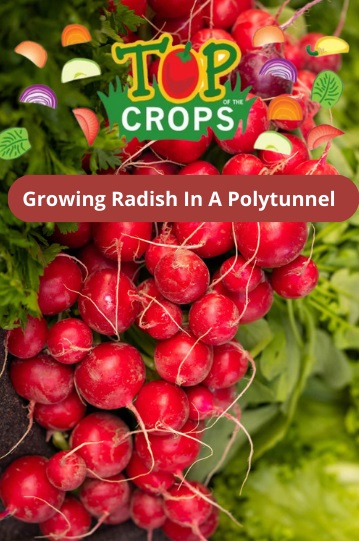Radishes are useful and healthy root vegetables easily grown in any home garden, even by complete beginners.
Radishes are a quick and easy crop that can really help you to make the most of the space in your polytunnel and can enliven your salads throughout most of the year, especially if you sow seeds little and often to ensure a continual supply during that period.
Not only can you grow radishes of all shapes, colours and sizes for their root, you can also let some radishes go to seed and collect hundreds of nutritious and delicious unripe seed pods that are a bit like mange tout but with a slight radish bite.
To grow radishes successfully, you need to understand what each of the types and varieties that you would like to grow require in terms of growing conditions. The key things to remember are that radishes generally need:
Full sun or partial shade.
Light, rich soil or growing medium high in organic matter, near-neutral in pH and moist yet free draining.
Radishes grown in the spring and summer are generally H2 hardy, meaning that they are tolerant of low temperatures but cannot survive a freeze. But there are also other radishes that can be grown over the coldest part of the year which are much hardier.
Radishes can be grown outdoors throughout much of the year, but a polytunnel extends the growing season even more and means that you can be harvesting your own home-grown radishes all year round.
| Jan | Feb | Mar | Apr | May | Jun | Jul | Aug | Sep | Oct | Nov | Dec | |
| Sow |  |
 |
 |
 |
 |
 |
 |
|||||
| Harvest |  |
 |
 |
 |
 |
 |
 |
 |
 |
 |
 |
 |
To grow radishes at home you will need:
Radish seeds of the specific type or types and variety or varieties you would like to grow.
A suitable growing location, whether outside or in a polytunnel, or even on a windowsill indoors, in pots, in raised beds, or in the ground.
Basic gardening tools.
Facility to water your radishes.
Organic matter for mulching/ feeding your crop.
Radishes of all kinds are remarkably easy to grow from seed. We cover the process in some depth below but you should rest assured that radishes are a great choice even for complete beginners or children to achieve. The seeds are easy to handle and germinate quite quickly, frequently within a week or so.
Radishes are a varied crop and not all are small, round and red. There are all sorts of different radishes with varying degrees of heat and crunch.
There are some varieties that are best planted in the spring and others that will be able to remain quite happily in your polytunnel throughout the winter.
Choose the right types and be sure to sow small quantities a little at a time rather than planting a whole load at once and ending up with a glut.
One of the things that you will need to decide first of all is which type and variety of radish you would like to grow. Some of the many different types and named cultivars that you might consider are discussed a little later in this guide.
Radishes can be grown in many different locations. They don't take up too much space and can be integrated in a great many different ways into your overall garden plans.
Remember, when deciding where to grow them, that radishes are not just useful edible crops. They can also be very useful companion plants, benefiting other plants close by in several different ways.
Times to sow depend on the type and variety that you have chosen to grow.
Salad radishes are sown from February onwards with protection. Winter radishes are usually sown in July or August. Some radishes can be sown from spring right through summer.
Wherever you have chosen to grow your radishes, before you sow you need to make sure that you have prepared the growing area. Make sure that the soil or growing medium is suitable for the radishes and that it is weed free.
Sow radish seeds near the surface of the soil or growing medium – simply sprinkle a little soil over them.
It is best to sow radishes in small successional batches, rather than sowing too many all at once, so that you have a staggered harvest and do not end up with a glut.
Most radishes are very quick to germinate and will do so within 4-7 days or so.
Radishes will be ready to harvest in as few as four weeks after sowing. If you continue to sow radishes from March right through to August then you can be eating radishes from May through to January.
Salad radishes need to be harvested while they are still relatively small, typically after around a month or so, or 6-8 weeks for the very earliest of sowings.
In hotter weather the bulbs will be stronger and, as a general rule, the longer you leave radishes in the ground, the spicier they will become. Simply pull radishes from the ground as needed as soon as small edible roots have formed.
Winter radishes are typically allowed to grow to larger size then harvested over the winter months. They can be harvested at the end of the growing season and stored over the winter, or left in the ground with protection and harvested as needed.
Daikon radishes, also known as oriental radishes, are usually harvested in the late summer or autumn but can also be protected and left in the ground over the winter months. They are sometimes used as a cover crop over the winter.
With these types, of course, we are not looking to harvest the roots but rather the seed pods. All radishes, it should be noted, also have edible seed pods, and edible leaves, but these are specifically grown for that part of the plant.
Radishes are not a crop that will take up a lot of your time, especially if you have chosen the right growing location and variety or varieties.
The main thing that you need to get right is watering. Radishes need consistent soil moisture to be at their best. Make sure that they receive enough water, and consistent water, throughout the growing season.
Often, radish seeds are sown in shallow drills in rows around 15cm apart, then thinned to an eventual spacing of around 2.5-15cm between plants, depending on the type and variety and the size at which harvesting takes place.
Mulching around your crop can help keep weeds down, while also protecting and improving the soil over time and providing nutrients for your radish crop. Weed carefully around your radishes so as not to disturb or damage the roots.
Radishes are best eaten as soon as possible after you harvest them from your garden. But they will store in the fridge for a few days.
Above, we have discussed the different types of radish that you might grow in the broadest of terms . Often, radishes are grouped into salad types, winter radishes, oriental radishes and varieties that are specifically grown for their pods rather than their roots.
Beyond these broad types, however, we also need to hone in on which specific varieties we would like to grow. Award-winning salad radish varieties, cultivars of Raphanus sativus, to grow in the UK include:
‘Amethyst’
‘Celesta’
‘Escala’
‘French Breakfast 4 Francis’
‘Mars’
‘Pink Beauty’
‘Rudolf’
‘Scarlet Globe’
‘Sparkler’
Winter radishes include daikon radishes or mooli types, Raphanus sativus var. longipinnatus, including beautiful watermelon radishes, which are also sometimes referred to as oriental or Asian radishes. Black Spanish radishes, Raphanus sativus L. var. niger, are also well worth considering growing over the winter months.
Then there are the radishes grown specifically for their pods, such as
Rat’s Tail
Dragon’s Tail
Munchen Bier
& Singara
Radish roots can fail to swell due to drying out, extreme heat, or overcrowding. Radishes can bolt in warm conditions, inconsistent watering can cause split roots, and roots that are not harvested in time can become bitter and woody. Usually, however, as long as you place and care for radishes correctly, they are not particularly problem prone.
However, occasionally, radish growers may experience problems with slugs and snails, cabbage root fly, flea beetles, or with certain other pests. Quick growing radishes are in fact sometimes used as trap crops for pests, helping to attract beneficial predatory insects and to keep pests away from other crops grown close by.
Radishes can thrive in a polytunnel as long as you water them properly and otherwise give them the care and conditions they need. They can also be useful as you can use them to help you in your gardening efforts, and to help other crops and they are a crop that allows you to become more self-reliant by saving your own seed for next year.
Use radishes to mark rows
Dashing a few radish seeds in with slow to germinate seeds such as carrots or parsnips will help to mark the rows so you do not weed out your crops accidentally. Radishes will be ready to harvest long before the second slower growing crop needs the space.
Use radishes to aid other crops.
Radishes make great companion plants for other crops, as attractants – especially when in flower – and as trap crops.
Save your own radish seeds.
If you would like to grow more sustainably and do not want to buy all your seeds in every year then radish seeds are amongst the easiest to save.
It is well worthwhile to allow a couple of radishes (you will need no more than two) to go to seed. The large straggling plants will flower, attracting beneficial insects, and then will produce abundant seed pods. Eat some, and allow others to dry completely so you can collect the seeds to sow next year.
Cole-Schmidt, G., (2023) The world's most valuable radish. BBC Travel. [online] Available at: https://www.bbc.com/travel/article/20231224-the-worlds-most-valuable-radish
